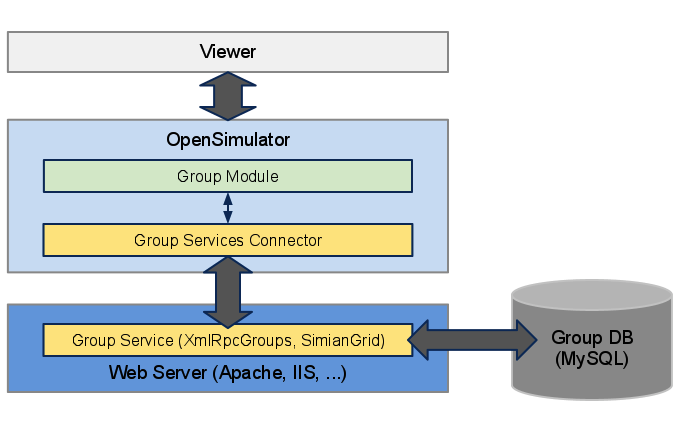Enabling Groups
From OpenSimulator
Contents |
Groups Overview
What is "Groups" in OpenSimulator?
Groups is facility that enables Groups support in OpenSimulator. See the "Group" article in SecondLife Wiki or the Group article on this Wiki for more details.
Components for the Groups
Groups consists of three components: the Group Service, the Group Services Connector and the Group Module. The groups service is a simple data service that stores data for in-world groups (e.g. group info, ranks or notices). It will often store this information in a database. All groups services are currently provided by third party projects that are not shipped with OpenSimulator. See the Feature_Matrix#Users for more details.
The groups service connector is the means by which OpenSim connects to the groups service, using the protocol handled by the service. The GroupsModule is the generic means by which the rest of OpenSimulator makes group requests. The groups module passes on requests to the configured services connector.
Thus, you will need to set up these three components to enable the Groups in your OpenSimulator. The following sections describe how to do that. Currently there are two known Group Services:
Please note that these are third party modules which you use at your own risk! OpenSimulator takes no responsibility for these modules.
You can even create your own Groups functionality by yourself, implementing IGroupServicesConnector and/or a groups service, depending on whether you want to use an existing protocol or make up your own (we highly recommend using an existing protocol if you can).
Requirements
If you want to run Group Services on your own, you need to know how to deploy your web applications on so-called web server, such as Apache or IIS.
XmlRpcGroups
Database Settings
First, create your database. If you don't even know how to install or login to MySQL, see Database Settings#MySQL Walkthrough. Note: If your MySQL database uses the utf8 character set, you may receive errors when creating the tables needed for groups in the table creation step below. A MySQL database using the latin1 character set should not have that issue.
mysql> create database opensim_group; mysql> use opensim_group; mysql> create user 'opensim_group'@'localhost' identified by 'opensim_group_password'; mysql> grant all on opensim_group.* to 'opensim_group'@'localhost';
Getting XmlRpcGroups
Download and extract the package from the following link.
http://code.google.com/p/flotsam/wiki/XmlRpcGroups
Creating Tables
Create tables inside your newly created database. In the package, you'll find 'groups.sql'. Run it.
mysql> source /(your_path_to_the_package)/groups.sql
It will create the tables for groups. If it succeed, the database has seven tables now. Note that the recent version(5.X) of mysql server may fail to create them. If so, change
- timestamp(14) to timestamp
- TYPE=MyISAM to ENGINE=MyISAM
and try again.
Deploying XmlRpcGroups
Deploy XmlRpcGroups php application to your web server.
For IIS: Copy the XmlRpcGroupsServer folder to c:\inetpub\wwwroot
Configuring XmlRpcGroups
Copy 'config.php.exmple' to 'config.php'. This file will be the configuration file for gorup service. At least, you need to fill in following properties like that:
$dbName = "opensim_group"; $dbHost = "localhost"; $dbPort = 3306; $dbUser = "opensim_group"; $dbPassword ="opensim_group_password";
Optionally, you can set these parameters to ensure the security of xmlrpc service:
$groupWriteKey = 'group_write_key'; $groupReadKey = 'group_read_key';
Note that if you want to enable UTF-8 characters in group descriptions, ranks or notices, you need to write this line in somewhere(between "<?php" and "?>") in config.php file to prevent them from getting garbled:
$xmlrpc_internalencoding = 'UTF-8'
Configuring Your OpenSimulator
Open OpenSim.ini file. In the [Groups] section, you'll find some properties. Change them so that it will look like that:
[Groups]
;# {Enabled} {} {Enable groups?} {true false} false
;; Enables the groups module
Enabled = true
;# {Module} {Enabled:true} {Groups module to use? (Use GroupsModule to use Flotsam/Simian)} {} Default
;; This is the current groups stub in Region.CoreModules.Avatar.Groups.
;; All the other settings below only really apply to the Flotsam/SimianGrid
;; GroupsModule.
;; This module can use a PHP XmlRpc server from the Flotsam project at
;; http://code.google.com/p/flotsam/
;; or from the SimianGrid project at http://code.google.com/p/openmetaverse
Module = GroupsModule
;# {MessagingEnabled} {Module:GroupsModule} {Is groups messaging enabled?} {true false} true
;MessagingEnabled = true
;# {MessagingModule} {MessagingEnabled:true} {Module to use for groups messaging} {GroupsMessagingModule} GroupsMessagingModule
MessagingModule = GroupsMessagingModule
;# {ServicesConnectorModule} {Module:GroupsModule} {Service connector to use for groups} {XmlRpcGroupsServicesConnector SimianGroupsServicesConnector} XmlRpcGroupsServicesConnector
;; Service connectors to the Groups Service as used in the GroupsModule. Select one depending on
;; whether you're using a Flotsam XmlRpc backend or a SimianGrid backend
ServicesConnectorModule = XmlRpcGroupsServicesConnector
;# {GroupsServerURI} {Module:GroupsModule} {Groups Server URI} {}
;; URI for the groups services
;; e.g. http://yourxmlrpcserver.com/xmlrpc.php for Flotsam XmlRpc
;; or http://mygridserver.com:82/Grid/ for SimianGrid
GroupsServerURI = "http://localhost/(context_path_to_deployed_xmlrpc_service)/xmlrpc.php"
;# {NoticesEnabled} {Module:GroupsModule} {Enable group notices?} {true false} true
;; Enable Group Notices
; NoticesEnabled = true
;; This makes the Groups modules very chatty on the console.
;DebugEnabled = false
;; XmlRpc Security settings. These must match those set on your backend
;; groups service if the service is using these keys
XmlRpcServiceReadKey = group_read_key
XmlRpcServiceWriteKey = group_write_key
As of OpenSimulator 0.7.1.X, you need to uncomment MessagingModule or ServicesConnectorModule line even if you are using GroupsMessagingModule or XmlRpcGroupsServicesConnector(#5543).

